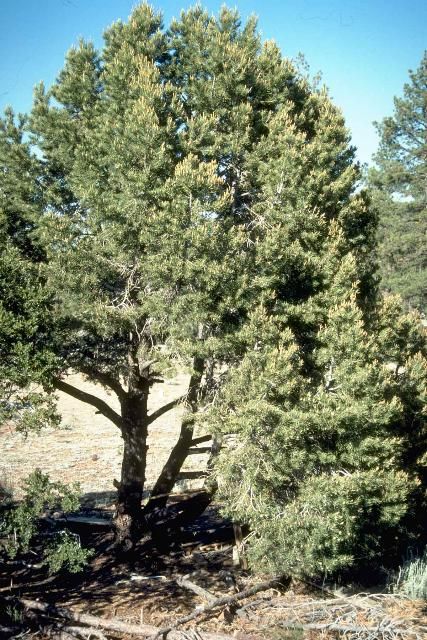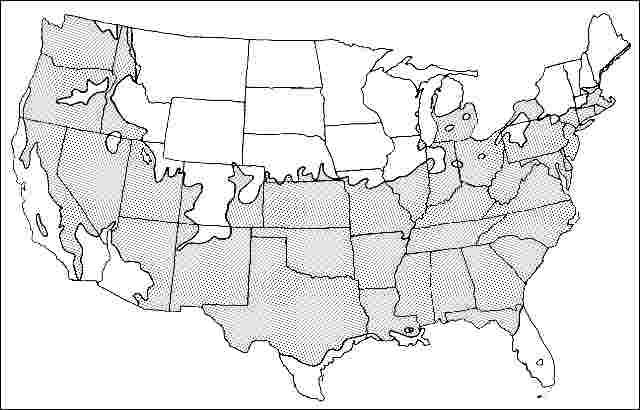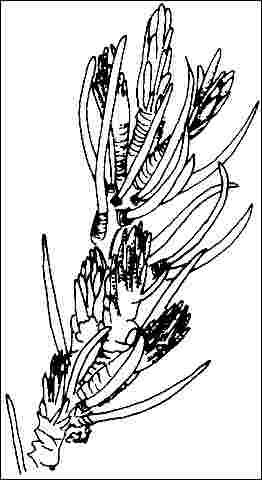Introduction
A native North American tree, Mexican Pinyon is usually found 20 to 30 feet tall with a spread of 15 to 20 feet, although it may sometimes be larger. It forms a compact, conical silhouette, producing a rounded canopy with age, and the lower branches are maintained on the tree, providing dense cover to the ground unless shaded-out by other growth. The stiff, blue/green needles are 1 to 1.5 inches long and the small, one to two-inch, yellow or red/brown cones mature and drop in autumn. The seeds found within the cones are quite popular with many birds and mammals - including man. Eaten either raw or toasted, Pinyon Pine nuts have a wonderful flavor.

Credit: Ed Gilman
General Information
Scientific name: Pinus cembroides
Pronunciation: PIE-nus sem-BROY-deez
Common name(s): Mexican Pinyon, Pinyon Pine
Family: Pinaceae
USDA hardiness zones: 5B through 8B (Fig. 2)
Origin: native to North America
Invasive potential: little invasive potential
Uses: specimen; highway median; Bonsai; reclamation
Availability: somewhat available, may have to go out of the region to find the tree

Description
Height: 20 to 30 feet
Spread: 15 to 20 feet
Crown uniformity: symmetrical
Crown shape: round
Crown density: moderate
Growth rate: slow
Texture: fine
Foliage
Leaf arrangement: alternate (Fig. 3)
Leaf type: simple
Leaf margin: entire
Leaf shape: needle-like (filiform)
Leaf venation: parallel
Leaf type and persistence: fragrant, needled evergreen, evergreen
Leaf blade length: less than 2 inches
Leaf color: blue or blue-green, green
Fall color: no color change
Fall characteristic: not showy

Flower
Flower color: red, yellow
Flower characteristics: not showy
Fruit
Fruit shape: irregular, oval, round, cone
Fruit length: 1 to 3 inches
Fruit covering: dry or hard
Fruit color: brown
Fruit characteristics: attracts squirrels/mammals; not showy; fruit/leaves a litter problem
Trunk and Branches
Trunk/bark/branches: branches droop; not showy; typically one trunk; thorns
Pruning requirement: little required
Breakage: resistant
Current year twig color: gray
Current year twig thickness: medium, thick
Wood specific gravity: unknown
Culture
Light requirement: full sun
Soil tolerances: clay; sand; loam; alkaline; acidic; well-drained
Drought tolerance: high
Aerosol salt tolerance: unknown
Other
Roots: not a problem
Winter interest: no
Outstanding tree: no
Ozone sensitivity: unknown
Verticillium wilt susceptibility: resistant
Pest resistance: resistant to pests/diseases
Use and Management
Mexican Pinyon should be grown in full sun on well-drained soil, tolerating dry, poor, alkaline soils but not wet soils. It is probably best not to irrigate this tree much after it is established in the landscape.
Pests
One pest of Mexican Pinyon is the Pine tip moth. Although it will kill some new growth, the result is simply to make the tree more compact since it has a pruning effect.
Diseases
No diseases are of major concern.